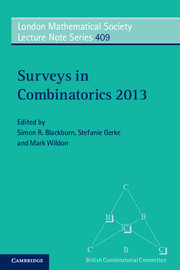Book contents
- Frontmatter
- Contents
- Preface
- 1 Graph removal lemmas
- 2 The geometry of covering codes: small complete caps and saturating sets in Galois spaces
- 3 Bent functions and their connections to combinatorics
- 4 The complexity of change
- 5 How symmetric can maps on surfaces be?
- 6 Some open problems on permutation patterns
- 7 The world of hereditary graph classes viewed through Truemper configurations
- 8 Structure in minor-closed classes of matroids
- 9 Automatic counting of tilings of skinny plane regions
- References
7 - The world of hereditary graph classes viewed through Truemper configurations
Published online by Cambridge University Press: 05 July 2013
- Frontmatter
- Contents
- Preface
- 1 Graph removal lemmas
- 2 The geometry of covering codes: small complete caps and saturating sets in Galois spaces
- 3 Bent functions and their connections to combinatorics
- 4 The complexity of change
- 5 How symmetric can maps on surfaces be?
- 6 Some open problems on permutation patterns
- 7 The world of hereditary graph classes viewed through Truemper configurations
- 8 Structure in minor-closed classes of matroids
- 9 Automatic counting of tilings of skinny plane regions
- References
Summary
Abstract
In 1982 Truemper gave a theorem that characterizes graphs whose edges can be labeled so that all chordless cycles have prescribed parities. The characterization states that this can be done for a graph G if and only if it can be done for all induced subgraphs of G that are of a few specific types, that we will call Truemper configurations. Truemper was originally motivated by the problem of obtaining a co-NP characterization of bipartite graphs that are signable to be balanced (i.e. bipartite graphs whose node-node incidence matrices are balanceable matrices).
The configurations that Truemper identified in his theorem ended up playing a key role in understanding the structure of several seemingly diverse classes of objects, such as regular matroids, balanceable matrices and perfect graphs. In this survey we view all these classes, and more, through the excluded Truemper configurations, focusing on the algorithmic consequences, trying to understand what structurally enables efficient recognition and optimization algorithms.
Introduction
Optimization problems such as coloring a graph, or finding the size of a largest clique or stable set are NP-hard in general, but become polynomially solvable when some configurations are excluded. On the other hand they remain difficult even when seemingly quite a lot of structure is imposed on an input graph. For example, determining whether a graph is 3-colorable remains NP-complete for triangle-free graphs with maximum degree 4 [92].
- Type
- Chapter
- Information
- Surveys in Combinatorics 2013 , pp. 265 - 326Publisher: Cambridge University PressPrint publication year: 2013
References
- 3
- Cited by



